
 |
Does a standard temperature need to be constant? |
Three methods of controlling relative humidity (RH) in museum stores are compared for energy use, based on data from three buildings. Full air conditioning is by far the most expensive. Next is conservation heating. Dehumidification without temperature control is by far the cheapest solution. Thermal and humidity buffers allow both conservation heating and dehumidification to operate within a safe annual temperature cycle: 15°C - 25°C for conservation heating, 10°C - 15°C for dehumidification. The saving in energy by using dehumidification rather than air conditioning is so large that the requirement for constant temperature expressed in many museum standards should be abandoned in favour of a permitted annual cycle within the range 10°C to 25°C. This will also give better chemical durability to organic materials than standards based on conditions for human comfort.
This article is an exploration of the consequences, in energy use and in conservation quality, of allowing museum temperature to vary more than many standards presently allow, while maintaining a nearly constant relative humidity. An analysis of three storage buildings shows that a great energy saving is possible if the requirement for constant temperature is relaxed. There is no scientific evidence that slow temperature variation within the historic indoor range for dwellings causes any detectable damage.
There are three ways of controlling the climate in a museum which must maintain a moderate winter relative humidity to avoid physical damage to artifacts through embrittlement or shear stresses in laminated materials. Air conditioning is the most energy hungry method. It also brings great complexity and a considerable volume of ducting. The cooling requirement forces the use of pumped air as the controlling medium, because summer cooling requires also dehumidification. The energy used by air conditioning cannot be calculated from basic physical properties of air and of materials, because it depends on the strictness of the specification. If the specification is very tight, the engineer will design a system which transports air through the ducts which is too cool and too dry. This air stream is warmed and humidified close to the injection point in each room or zone, thus compensating for variation in the heat and air loss from different places in the building. This means that the air is being cooled and heated at the same time. Even if this refinement is not included, the alternation between heating and cooling, to maintain a constant room temperature, is also wasteful of energy.
The second method of controlling humidity is conservation heating. In northern Europe the relative humidity indoors will attain roughly 50% if the room air is heated about 6°C above ambient temperature. This will result in an annual variation between about 6°C and 28°C. However, if the interior is reasonably airtight and well buffered against humidity change, it is possible to reduce the annual temperature cycle to about 15°C - 25°C, providing a temperature acceptable to humans while maintaining a constant RH for the benefit of the objects. We call this 'buffered conservation heating'.
The third method of humidity control is dehumidification. The temperature must be allowed to drift down in winter, otherwise the relative humidity will drop below the dehumidifier's set point, so control is lost. However, as with conservation heating, relative humidity buffering can be used to reduce the annual temperature cycle. In north west Europe the temperature will not need to go below 10°C.
Full air conditioning allows a museum to keep within the human comfort zone all through the year. The relatively high annual temperature is not advantageous to the durability of the objects, which is generally improved by lower temperature. In museum stores and archives the temperature can be allowed to drift down in winter with benefit to the chemical durability of the objects and without significant inconvenience to the staff. We have ample evidence that museum storage is best achieved with dehumidification of a tightly sealed building. However, optimising energy use in exhibition areas is not so easy.
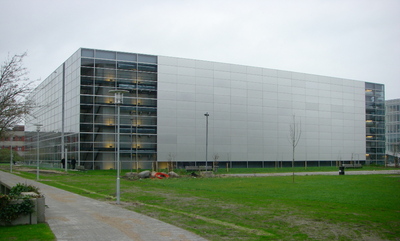
Figure 1: A storage building of the Royal Library in Copenhagen, completed in 2000. It is permanently air conditioned to a set point at 18°C and 50% RH.
There is a standard for archive climate that is widely used around the world, though it was developed for use in the United Kingdom. BS 5454:2000 specifies, for frequently accessed stores, a constant temperature between 17°C and 18°C with an extra permitted variation of +/- 1°C. (BS 5454 2000) This is plotted on Fig.2 over a background diagram which is based on Don Sebera's concept of the isoperm: a set of lines of equal reaction rate, based on an activation energy of 100kJ/mole and a proportional influence of relative humidity. (Sebera 1994, Padfield 2004) This could, for example, be a typical hydrolytic degradation process of paper. In the diagram we set the isoperm passing through the normal room conditions of 20°C and 50% RH to one. As one moves to a colder or drier region, the reaction rate diminishes.
The actual performance of the Danish Royal Library is superimposed on this diagram. The specification is close to BS 5454 but the summer temperature cannot be held to the standard. The annual energy consumption is 30 kWh/m3.
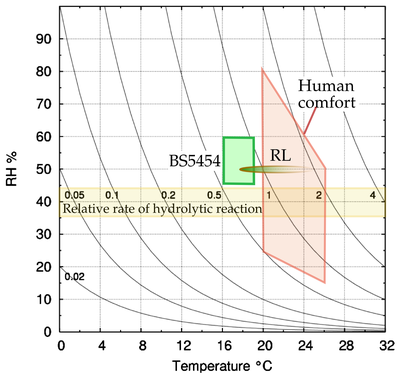
Figure 2: Sebera type diagram (see text for explanation) with BS 5454:2000 and Royal Library (RL) climate limits superimposed.
The much smaller archive of the Arnamagnæan archive in Copenhagen University (Fig.3) has buffered conservation heating. The climate is displayed in Fig. 4. The winter temperature is held up above ambient by heat leaking from the inhabited part of the building. Relatively thin insulation to the outside ensures that the archive temperature is about half way between the building temperature and the outside. This, combined with the humidity buffering by the room walls and by its contents, ensures a steady RH, even though the water vapour concentration is different from that outside over long periods. Fine tuning of the RH is achieved through pumping in outside air when, by chance, it has the right water vapour concentration to correct the inside RH.
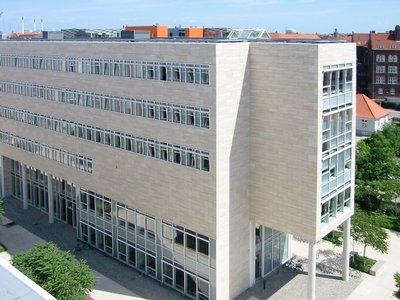
Figure 3: A building of Copenhagen University. The Arnamagnæan archive is behind the portion of wall without windows. It has no internal heating but gains heat from the core of the building, which is kept within the human comfort zone. Heat loss to the outside through thin insulation on the two exterior walls keeps the archive temperature about midway between indoor and outdoor temperatures.
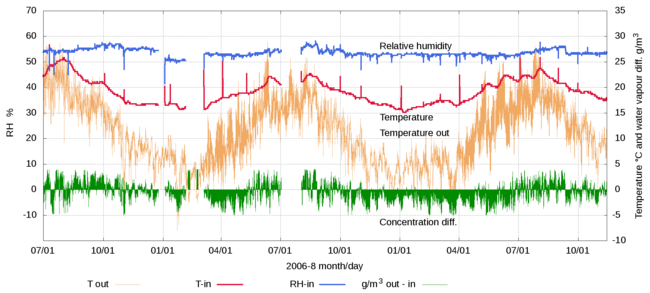
Figure 4: The climate within the Arnamagnæan archive. The lowest trace is the difference between the water vapour concentrations inside and out. When the shaded area is below zero, there is excess water vapour within the archive.
The Arnamagnæan archive has no direct heat input but one can calculate the heat flow to the outside from the details of construction. The heat loss is about 13 kWh/m3 per year. This seems large, but the room is small, 10 x 4 x 3 m high, so the ratio of volume to surface area is quite small.
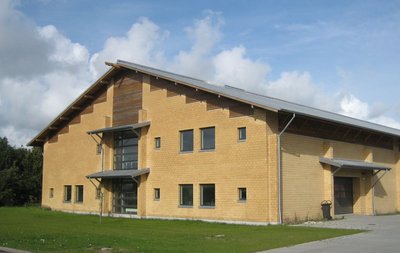
Figure 5: The museum store in Ribe, southern Denmark. The building is heavily insulated and nearly airtight.
The museum store in Ribe, in south west Denmark, is much larger: about 6,500 m3. It is dehumidified. The temperature is allowed to follow the running average outside temperature, though, as with the Arnamagnæan archive, there is some heating by leakage from inhabited regions of the building.

Figure 6: The climate in the Ribe store generally has a constant RH with an annual temperature cycle between 10°C and 15°C. However, when the equipment fails, particularly in summer, the RH rises quite quickly, indicating inadequate humidity buffering for fail-safe operation.
The climate is shown in fig. 6. The temperature cycle is impressively gentle, considering there is no direct control. The RH is normally constant but rises quite rapidly when the dehumidifier is turned off, as happened on two occasions. In winter, the humidity rise is gentle but in summer the RH rises to a dangerous degree within two weeks. The building would benefit from better humidity buffering to make it more tolerant of equipment failure. The energy used for dehumidification is 0.7 kWh/m3 per year. The total energy use is a bit larger because a fan is used to distribute the dehumidified air and there is some leakage from heated parts of the building. Even these sources will scarcely bring the usage above 1.1 kWh/m3 per year. The minimum temperature in Ribe is 10°C.
The climate ranges of the three buildings are plotted on fig. 7. One should not over-interpret these findings from a small sample but there is no doubt that dehumidification with temperature following the outside climate gives the slowest rate of chemical degradation.
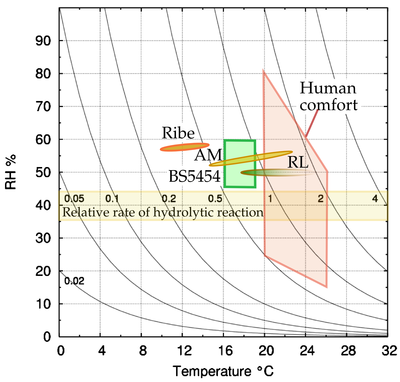
Figure 7: The British Standard for archives, BS 5454:2000, and the climate ranges of the three studied buildings, are superimposed on the Sebera type diagram introduced in fig.2. RL: Royal Library, AM: Arnamagnæan archive.
These three buildings illustrate the three broad categories of climate control. We don't claim that their energy use is universally typical, but there is no doubt that full air conditioning is very much more expensive than the alternative conservation heating or dehumidification. The balance between energy use by these last two methods is shown in fig.8.
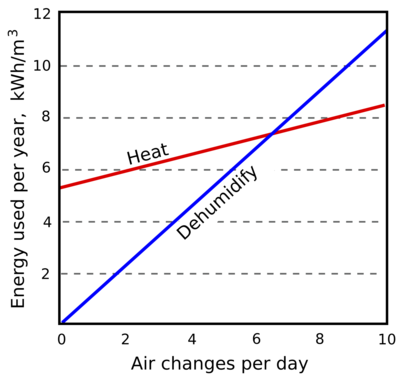
Figure 8: A comparison of the energy use predicted for the Ribe store by conservation heating, compared with dehumidification. The RH is set at 60%, the store has a surface area of 0.5 m2 per m3 and the U-value (thermal conductance of the building envelope) is set to 0.3 W/m2.K, which is a good insulation quality. The air change must exceed 6 times per day before conservation heating becomes cheaper than dehumidification.
If the air exchange rate is zero, dehumidification costs nothing, after the initial drying of the building and contents. In practice, it is possible to get the air exchange rate in a storage building down to less than once per day. Ribe has about 0.7 air changes per day, The Arnamagnæan archive has about 5 air changes per day.
It is not possible to bring the heating energy down to match that of dehumidification. The Ribe building is insulated with 250 mm of mineral wool and has a large ratio of volume to surface area. The heat loss without any air exchange corresponds to five air changes per day. For a new store, dehumidification is clearly a better choice, giving better durability to the objects. However, hybrid operation is possible, with waste heat from the dehumidifier and from adjacent heated spaces giving a measure of conservation heating.
For exhibitions, the choice of climate control principle is not so clear cut. Buffered conservation heating will probably give better human comfort, providing temperature and humidity buffering is large. With current building technology, the daily peak in temperature can be largely eliminated, even in exhibition spaces with many visitors. Humidity buffering remains an immature technology. We suggest that improving humidity buffering of inhabited spaces is an important step towards saving energy in museums.
The two low energy stores we have described rely on a very low air exchange rate with outside, and they have also a fairly low re-circulation rate within the store. Museum standards advocate 'good ventilation' in varied choice of words. This advice may be based on an unsubstantiated belief that ventilation inhibits mould growth and ignores the role of air movement in spreading dust, spores and volatile chemicals. Inhibition of mould growth by air movement is due to the indirect influence of air movement in equalizing the temperature throughout a room, thus preventing the high RH that develops in cold corners of a warm room. Inhabited rooms usually have a higher water vapour concentration than outside because of human metabolism and other water vapour generating activities, so the RH in cold places, behind furniture set against the outer wall for example, can reach 100% even when the outside RH is moderate. In a purpose built museum store the human presence is minimal, the temperature difference between inside and outside is small and the building can be designed not to have cold corners. For these buildings, the standard advice is not relevant.
A low air exchange rate minimises entry of pollutants formed outside but fails to flush out pollutants generated inside. Fig.9 shows how the inside concentration of ozone, as modeled for a room the size of the Arnamagnæan archive, depends on the air exchange rate. To reduce the indoor ozone concentration below 10% of that outdoors, the air exchange rate must be 0.2 per hour or less. The typical outdoor concentration is 20-40 ppb for northern Europe. However, peak values can reach beyond 100 ppb.
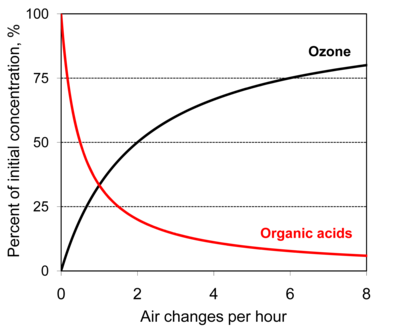
Figure 9: The indoor pollution concentration depends on the air exchange rate. For chemicals generated indoors, the starting point is the steady-state concentration at near-zero ventilation (100%). For compounds such as acetic acid this may be several hundred ppb. Outdoor pollutants decrease in concentration (from an ambient level of 100%) as they are absorbed by deposition on surfaces on their route into a building and within the room. A low air exchange rate retards ingress from outdoors, but at the same time blocks the escape of internally generated pollutants. The model assumes a room comparable to the Arnamagnæan archive, and is based on steady state conditions for outdoor and indoor generation of pollutants [Ryhl-Svendsen 2006].
In contrast to this is the increase in concentration of pollutants generated indoors as the air exchange rate diminishes. If indoor sources of pollutant are present, from interior furnishing or from the stored objects themselves, the concentration in the air will build up until the rate of reaction equals the rate of production. Organic acids are known to be corrosive to some metals and to damage organic materials such as cotton fibres. Recirculation through an air filter will imitate the action of ventilation to the outside, so a circulation rate of twice per hour will greatly reduce the concentration of internally generated pollutants.
Deciding the optimum rate of recirculation depends on estimating how much of the pollutant will react within the immediate enclosure, such as a can of acetate film, an archival box, or a book, and how much will escape into the room air to react with other objects in the collection.
The energy saving that comes from allowing a slow annual cycle of temperature in museums and museum stores is so large that passive acceptance of the authority of inflexible standards is no longer sustainable, neither on scientific nor on energy efficiency considerations. The guardians of our standards must now justify them scientifically, on the basis of existing knowledge, or allow relaxation of the temperature limits. There is no case for delay while we continue to establish damage functions for very slow reactions. We do not even have to debate the need for compromise: the experimental evidence accumulated over a hundred years confirms that allowing a drift to lower winter temperature is good for the conservation of many objects and harms none. The period of summer temperature above the standard specification can be reduced by careful attention to lighting efficiency and to the thermal and humidity capacity of the building envelope and interior structures. Our research effort should be directed towards highly buffered building design, design of buildings and sites which optimise solar gain, and efficient use of light, both natural and artificial.
We thank Mette Jakobsen for the climate data from the Arnamagnæan archive, Svend Jørgensen for information about the Ribe store and Christian Bruun and Marie Vest for information about the book storage building of the Royal Library.
BS 5454:2000, Recommendations for the storage and exhibition of archival documents. British Standards Institute, London.
Padfield, T. 2004, The isoperm and the isoburn
http://www.padfield.org/tim/cfys/twpi/twpi_03.php (accessed 10 May 2009).
Ryhl-Svendsen, M. 2006, Indoor air pollution in museums: a review of prediction models and control strategies. Reviews in Conservation 7, 27-41
Sebera, D. 1994, Isoperms, an environmental management tool. The Commission on Preservation and Access, Washington DC.
http://palimpsest.stanford.edu/byauth/sebera/isoperm/ (accessed 10 May 2009).
This article was submitted (May 2009) to the Going Green conference at the British Museum. A pdf version is available here.
Creative commons licence: free to use for any purpose, but the authors must be acknowledged and no changes may be made.

This work is licensed under a Creative Commons Attribution-Noncommercial-No Derivative Works 3.0 License.